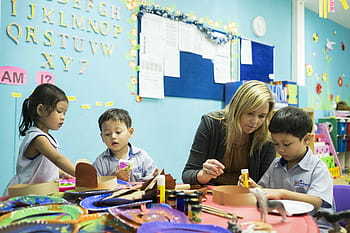Much like many of the other homeschooling styles, the Montessori style focuses on allowing children to learn at a pace that suits their potential and development. It helps to encourage a child’s confidence, independence, dignity, and self-awareness. Focusing specifically on ages birth to preschoolers to upper elementary age, this style is one of the most deeply developed methods that can be used in the homeschool setting.
In the Montessori learning style, anything that would cause confusion and cluttered thinking is avoided, as are television and screen time. This is especially true for children that are younger or just getting started on their learning adventure. It can often be viewed as an intense method of homeschooling, but the results usually speak for themselves.

Why Choose the Montessori Style?
The Montessori homeschooling style is based on the Montessori Method which was first developed by Maria Montessori in the early 1900s. This program is very well known and has been utilized all over the globe for more than 100 years. The most important approaches carried out in this style aim to create positive results in the areas of self-awareness, becoming connected with others, and being productive adults. And it all starts during those early critical years in young children when foundations are being formed.
This homeschooling style also helps children to learn problem-solving techniques, patience, self-discipline, practical life, and compassion for others and the environment. Often, a parent’s role in the Montessori style is to provide more guidance than strict leadership and a set program. Helping a child ‘find themselves within the scope of reason is a primary goal, usually with excellent results.
Setting up a space in which to teach the Montessori Method is simple. The focus is on making sure that all furniture, materials, toys, and tools are child-sized, uncluttered, and easily accessible. Shelves that are low and on the child’s level make accessibility easier and helps them to feel more confident in choosing materials and books as well as putting them away when it’s time to do so.
Advantages of the Montessori Style
According to this style, we are taught that children learn because that’s just what they do. Especially in the early years. And the more effort we put into offering an environment that caters to that attribute, the faster and more easily the child will learn. Modeled behavior is also important in this style and it takes the place of direct teaching. It’s very much like the old saying, “Show, don’t tell.” The child-led learning model builds on their abilities and natural development which creates a happier child.
Learning is made much more interesting because the process offers a very hands-on approach with materials that encourage the desire to use them. This kind of learning is known to help children retain the information better, especially in cases where the child has special needs. The resources are an excellent mix of tactile, auditory, and visual materials and repetition is key.
A Montessori school style of academics hinges on eight basic principles that can easily be tailored for the homeschooling family:
- Movement and Perception: The fact that these two things are closely related gives a foundation to the fact that moving can actually aid the learning and thinking processes. A great example of how this works is the Gillian Lynne story. As a public-school student, she was assessed for learning disorders because she was fidgety and extremely restless in class. Her level of concentration was practically nil. Upon being sent to a specialist, it was determined that she wasn’t sick, but rather a dancer who needed an outlet. After studying dance, she went on to become a famous choreographer contributing to such productions as Cats and Phantom of the Opera.
- Options: Allowing children to have a part in the choices that affect their lives can greatly improve their ability to learn as well as their overall level of happiness. For instance, you could allow them to choose their own healthy snacks from an assortment, choose their own schedule created from a list of work assignments for the day, or choose the book they’d like to read when time to do so. You might also allow them to pitch ideas for field trips, playdates, and movie nights.
- Organization: Organization is as important for the mind as it is for the setting in which the child learns. Workboxes, separated by subject, are an excellent way to keep up with engaging resources. Whichever space you dedicate for learning, make sure that it remains uncluttered, but still allows easy access to a shelf where they can find materials for art projects, reading, etc. One way to implement the child’s help in this is to dedicate the last ten minutes of the day to “cleaning time”. Usually, five to ten minutes is enough for this endeavor, as these little increments on a daily basis erase the need for one massive cleaning at the end of the week.
- Contextual Learning: Providing context to any learning experience is an excellent way to dive deeper into specific subjects, especially when those concepts are abstract. For instance, creating a homemade recipe is a better approach than simply discussing the process from watching a video. You can better explain budgets by making a list and visiting a grocery or department store, especially around the holidays. And we can’t forget that children raised on a farm have many ways to engage with the environment for hands-on, real-life learning.
- Interest-Based Learning: Have you ever noticed how much more quickly you retain information when you’re interested in the information or subject matter? It’s the same way for children! Catering to your child's interests is a great way to make learning fun, memorable, and encourage the love of learning. Lapbooks are a fun way to learn about hobbies, specific historical periods, music, animals, and so much more. Unit studies work the same way, by addressing one topic across all subject matter.
- Peer-Learning: Another way not only to spark interest in a subject but also to aid in the retention of the information learned, is to work in a collaborative environment. Team sports, debate teams, study groups, and hobby-party hosting can be an excellent way to bring like-minded children together around a subject. What’s more, this is as beneficial to their social development as for their academic growth.
- Teacher-Child Interactions: One of the best ways to instill certain thought processes and modes of learning is to model behaviors. Working alongside your child in specific subject matters is one thing, but respecting what they think is primarily a “Teacher Activity” (where you are their teacher, of course). Set up a weekly “meeting” with them to review the week’s achievements. Let them choose how to decorate a family gathering space or room. Have them help you decide on specifics for the curriculum. Let them help with the lesson plans for the week. They will greatly appreciate the opportunity to see that their opinions matter.
- Avoid “Rewards Vs. Punishments”: Some rewards work nicely. For instance, the feeling you get from a job well done, or knowing you made a good decision simply because it was right to do so. On the other hand, when you reward children with something like money, food, or the opportunity to do something they wouldn’t normally get to do, you are actually creating the mentality that in order to be rewarded, they must pass a certain goal set before them. This can backfire if there is no reward, as the child will think there is nothing to work toward.
Disadvantages of the Montessori Style
Amidst the many advantages to this style of homeschooling, the Montessori Homeschool Method does come up against what some would view as disadvantages as well. There is some debate as to whether homeschooling parents actually have the ability, without specific Montessori teacher training, to teach this particular method. Because of this, some parents decide to take courses and training that will equip them for the task ahead. Others, on the other hand, simply order the Montessori materials and go forward in that way.
The Montessori principles are quite rigid, with a great deal of structure. Specific toys and tools are necessary at specific age levels, and they are divided into groups, e.g. sensory, language, science, math, art, and much more. Each set has specific colors and shapes, and some parents find this rigidity to be outside the scope of what they had hoped homeschool would be. Some parents tweak the program to fit their style, whereas others forego the method altogether.
The cost of all the add-ons necessary to make this program truly work is another factor that some parents find burdensome. Although it can certainly be done on a budget, with DIY materials and free printables making good substitutions, it still amounts to a great deal of money spent on curriculum, supplies, and resources.
Is the Montessori Homeschooling Style Right for Our Family?
Across the board, you’ll find that the answer to this question is always based on very specific requirements and preferences. However, when it comes to breaking down the idea of one specific style, you can compare and contrast to get a good idea of what really works for you.
So far, we’ve found that the traditional Montessori Method is very structured and rigid, yet also focused on child-led learning. Does the combination of these things conflict with your way of thinking? It’s also based on the environment remaining very organized and completely uncluttered. Does this sound like your household? Or does it sound like something you want to accomplish or set as a goal for your homeschool?
Of course, you can’t forget about the expense. Be sure to take a look at exactly what you’re going to need based on how many children you have and their ages. The materials are created to work well for multi-level homeschool rooms, but the primary focus is on ages birth through six years. If you have children older than this, changes will most certainly have to be made to accommodate them if you’re going to maintain using Montessori education.
The Montessori Curriculum & Resources
The curriculum available for the Montessori homeschooling style can be divided into the following categories:
- Infants and Toddlers
- Early Childhood
- Lower Elementary
- Upper Elementary
There are lots of ways to put together a Montessori homeschool curriculum. Many parents adhere rigidly to every suggested course and resource, while others choose to “mix and match.” Finding the specific pieces of the puzzle to create a successful Montessori learning experience for your child or children means that you will have to do some research into which methods adhere best to your own beliefs, core values, and goals for the future.
One of the very best ways to determine your curriculum needs is to attend a convention where vendors and exhibitors will have extensive varieties of materials that you can examine for yourself. Literally getting your hands on the materials, the workbooks, the toys and tools, and the huge variety of other resources can be a major turning point, because you’ll get to see for yourself, up close and personal, how the material is laid out, front to back and start to finish. Instead of ordering blindly from an online company and wondering what the materials will actually be like when they arrive, a convention gives you a wide-open homeschool world to explore at your convenience. If you have the opportunity to take advantage of this, I strongly encourage you to do so!
Montessori Groups & Co-ops
The Montessori style is one that makes great use of homeschool co-ops, groups, and clubs. With a focus on learning amongst peers, this is a great opportunity for children to take part in group activities such as sports, hobbies, crafts, cooking, and many others. You can find lots of information on social media, but be very careful to do your research before connecting with any group in person.
Special Considerations for the Montessori Homeschooling Style
As stated throughout this article, opinions vary greatly on the “untrained” parent’s ability to administer this academic style without the proper classes and training. Be sure to do your ‘homework’ as you evaluate any Montessori resources to make sure they are homeschool-friendly and adaptable to your intended style and methods of teaching. The same is true as you choose the curriculum and tools necessary for the Montessori way.

In Closing
If you are interested in the Montessori homeschooling style, we strongly urge you to consider attending one of our seven regional Great Homeschool Conventions. Remember that these are regional gatherings, meaning that people come from all over the United States to attend.
To make it easier for families to do so, we offer hotel discounts, military discounts, and active clergy members may attend for free. CLICK HERE to register and save $10.
And remember, our Great Homeschool Conventions are: Equipping… Encouraging… FUN!
